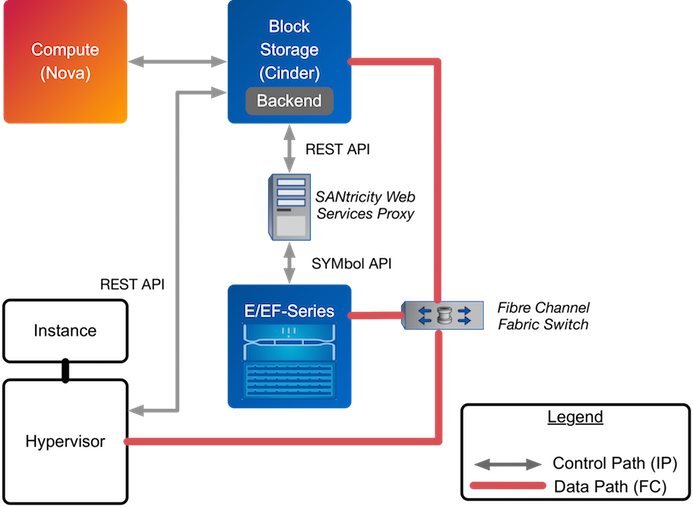Theory of Operation: NetApp Unified Driver for E-Series with Fibre Channel¶
- E-Series drivers are being deprecated and will be removed after the S release
In order for Fibre Channel to be set up correctly, you also need to set up Fibre Channel zoning for your backends. See the section called Fibre Channel & cinder.conf for more details on configuring Fibre Channel zoning.
As described in the section called “Theory of Operation and Deployment Choices”, Cinder with NetApp E-Series requires the use of the NetApp SANtricity Web Services Proxy server deployed as an intermediary between Cinder and the E-Series storage system. A common deployment topology with Cinder, Nova, and an E-Series controller with the SANtricity Web Services Proxy can be seen below in Figure 4.8, “Cinder & E-Series Deployment Topology”.
Tip
Installation instructions for the NetApp SANtricity Web Services Proxy server are available for download at https://library.netapp.com/ecm/ecm_download_file/ECMLP2428355, and the User Guide is available for download at https://library.netapp.com/ecm/ecm_download_file/ECMLP2428357.
Dynamic disk pools (as described in the section called “Description of E-Series and EF-Series Systems) and volume groups are the supported disk collection strategies when utilizing the Cinder E-Series driver. For more information on the capabilities of the E-Series storage systems, visit http://support.netapp.com.
Important
The use of multipath and DM-MP are required when using the OpenStack Block Storage driver for E-Series.
Important
In order for Fibre Channel to be set up correctly, you also need to set up Fibre Channel zoning for your backends. See “Fibre Channel & cinder.conf” for more details on configuring Fibre Channel zoning.
Important
In order for OpenStack Block Storage and OpenStack Compute to take advantage of multiple paths, the following configuration options must be correctly configured:
- The
use_multipath_for_image_xfershould be set toTrueincinder.confwithin the driver stanza.
This document is licensed under Apache 2.0 license.
